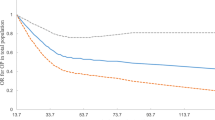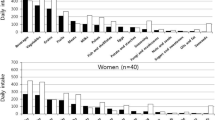Abstract
Background and aims: Selenium is of fundamental importance to human health. Our aim was to evaluate the effect of selenium (intake and serum levels) on subjective indicators of quality of life in older people, such as self-perceived health, chewing ability and physical activity. Methods: The sample was a cohort of 227 elderly people (93 men and 134 women) residing in 14 nursing homes in Asturias (Spain). Mean age ± SD was 72.9±7.2y and 76.4±5.9y, for men and women respectively. Information was collected in personal interviews. Dietary intake was recorded by means of a food-frequency questionnaire. Selenium was determined in serum by graphite-furnace atomic absorption spectrometry. Results: Serum selenium was associated with self-perceived health, chewing ability and physical activity in this sample. Subjects in the upper tertile of serum selenium had more than twice as much probability (Odds Ratios, 2.05 to 3.157) of reporting good health status, good chewing ability and of doing more than 60 min of exercise/day. Conclusions: The maintenance of good serum selenium levels is important, since it may affect the self-perception of health, chewing ability, or physical activity and, consequently, the quality of life in elderly people.
Similar content being viewed by others
References
Boscolo P, Di Giampaolo L, Qiao N, et al. Inhibitory effects of cadmium on peripheral blood mononuclear cell proliferation and cytokine release are reversed by zinc and selenium salts. Ann Clin Lab Sci 2005; 35: 115–20.
Brauer AU, Savaskan NE. Molecular actions of selenium in the brain: neuroprotective mechanisms of an essential trace element. Rev Neurosci 2004; 15: 19–32.
Broome CS, McArdle F, Kyle JA, et al. An increase in selenium intake improves immune function and poliovirus handling in adults with marginal selenium status. Am J Clin Nutr 2004; 80: 154–62.
Cunningham-Rundles S, McNeeley DF, Moon A. Mechanisms of nutrient modulation of the immune response. J Allergy Clin Immunol 2005; 115: 1119–28.
Patrick L. Selenium biochemistry and cancer: a review of the literature. Altern Med Rev 2004; 9: 239–58.
Quercia RA, Korn S, O’Neill D, et al. Selenium deficiency and fatal cardiomyopathy in a patient receiving long-term home par-enteral nutrition. Clin Pharm 1984; 3: 531–5.
Murphy J, Cashman KD. Selenium status of Irish adults: evidence of insufficiency. Ir J Med Sci 2002; 171: 81–4.
WHO. About ageing and life course. Available at: http://www.who.int/hpr/ageing/index.htm. Accessed: 4–5 2005.
Idler EL, Angel RJ. Self-rated health and mortality in the NHANES-I Epidemiologic Follow-up Study. Am J Public Health 1990; 80: 446–52.
Lindsted KD, Tonstad S, Kuzma JW. Self-report of physical activity and patterns of mortality in Seventh-Day Adventist men. J Clin Epidemiol 1991; 44: 355–64.
Rakowski W, Mor V. The association of physical activity with mortality among older adults in the Longitudinal Study of Aging (1984–1988). J Gerontol 1992; 47: M122–9.
Froom P, Melamed S, Triber I, Ratson NZ, Hermoni D. Predicting self-reported health: the CORDIS study. Preventive Medicine 2004; 39: 419–23.
Lee JS, Weyant RJ, Corby P, et al. Edentulism and nutritional status in a biracial sample of well-functioning, community-dwelling elderly: the Health, Aging, and Body Composition Study. American Journal of Clinical Nutrition 2004; 79: 295–302.
Miura H, Miura K, Mizugai H, Arai Y, Umenai T, Isogai E. Chewing ability and quality of life among the elderly residing in a rural community in Japan. J Oral Rehabil 2000; 27: 731–4.
Benyamini Y, Leventhal H, Leventhal EA. Self-rated oral health as an independent predictor of self-rated general health, self-esteem and life satisfaction. Soc Sci Med 2004; 59: 1109–16.
Pla GW. Oral health and nutrition. Prim Care 1994; 21: 121–33.
Instituto de Nutrición. Tablas de Composición de Alimentos. CSIC. 1994.
Jiménez A, Cervera P, Bacardi M. Tabla de Composición de Alimentos. Wander. Sandoz Nutrition, 1990.
Jacobson BE, Lockitch G. Direct determination of selenium in serum by graphite-furnace atomic absorption spectrometry with deuterium background correction and a reduced palladium modifier: age-specific reference ranges. Clin Chem 1988; 34: 709–14.
Appollonio I, Carabellese C, Frattola A, Trabucchi M. Dental status, quality of life, and mortality in an older community population: A multivariate approach. J Am Geriatr Soc 1997; 45: 1315–23.
Avlund K, Holm-Pedersen P, Schroll M. Functional ability and oral health among older people: A longitudinal study from age 75 to 80. J Am Geriatr Soc 2001; 49: 954–62.
Takata Y, Ansai T, Awano S, et al. Relationship of physical fitness to chewing in an 80-year-old population. Oral Dis 2004; 10: 44–9.
Parko A. Has the increase in selenium intake led to a decrease in caries among children and the young in Finland. Proc Finn Dent Soc 1992; 88: 57–9.
Sheiham A, Steele J. Does the condition of the mouth and teeth affect the ability to eat certain foods, nutrient and dietary intake and nutritional status amongst older people? Public Health Nutr 2001; 4: 797–803.
Posner BM, Jette A, Smigelski C, Miller D, Mitchell P. Nutritional risk in New-England elders. J Gerontol 1994; 49: M123–32.
Sahyoun NR, Lin CL, Krall E. Nutritional status of the older adult is associated with dentition status. J Am Diet Assoc 2003; 103: 61–6.
Sheiham A, Steele JG, Marcenes W, Tsakos G, Finch S, Walls AWG. Prevalence of impacts of dental and oral disorders and their effects on eating among older people; a national survey in Great Britain. Community Dent Oral Epidemiol 2001; 29: 195–203.
Sheiham A, Steele JG, Marcenes W, Finch S, Walls AWG. The relationship between oral health status and Body Mass Index among older people: a national survey of older people in Great Britain. Br Dent J 2002; 192: 703–6.
Hung HC, Joshipura KJ, Colditz G, et al. The association between tooth loss and coronary heart disease in men and women. J Public Health Dent 2004; 64: 209–15.
Joshipura KJ, Wand HC, Merchant AT, Rimm EB. Periodontal disease and biomarkers related to cardiovascular disease. J Dent Res 2004; 83: 151–5.
Shimazaki Y, Soh I, Saito T, et al. Influence of dentition status on physical disability mental impairment, and mortality in institutionalized elderly people. J Dent Res 2001; 80: 340–5.
Author information
Authors and Affiliations
Corresponding author
Rights and permissions
About this article
Cite this article
González, S., Huerta, J.M., Fernández, S. et al. Life-quality indicators in elderly people are influenced by selenium status. Aging Clin Exp Res 19, 10–15 (2007). https://doi.org/10.1007/BF03325205
Received:
Accepted:
Published:
Issue Date:
DOI: https://doi.org/10.1007/BF03325205




